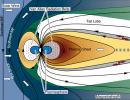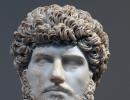Pendulum clock: From Galileo to Fedchenko. Hours of discord Mechanism improved by Galileo and Huygens
(1663), member of the French Academy of Sciences since its founding (1666) and its first president (1666-1681).
| Christiaan Huygens | |
|---|---|
| Christiaan Huygens | |
| Date of Birth | 14th of April(1629-04-14 ) […] |
| Place of Birth | |
| Date of death | July 8(1695-07-08 ) […] (66 years old) or June 8(1695-06-08 ) (66 years old) |
| A place of death | |
| A country | |
| Scientific field | mathematics, mechanics, physics, astronomy |
| Place of work | French Academy of Sciences |
| Alma mater | Leiden University |
| Scientific director |
Frans van Schoten Jan Jansz de Jonge Stampioen |
| Famous students | Gottfried Leibniz, Denis Papin |
| Known as | one of the founders of theoretical mechanics |
| Christiaan Huygens at Wikimedia Commons | |
Biography
The young Huygens studied law and mathematics at the University of Leiden, then decided to devote himself to science. In 1651 he published “Discourses on the quadrature of the hyperbola, ellipse and circle.” Together with his brother, he improved the telescope, bringing it to 92-fold magnification, and began studying the sky. Huygens first became famous when he discovered the rings of Saturn (Galileo also saw them, but could not understand what they were) and the satellite of this planet, Titan.
In 1657, Huygens received a Dutch patent for the design of a pendulum clock. In the last years of his life, Galileo tried to create this mechanism, but his progressive blindness prevented him. Other inventors also tried to create clocks based on a pendulum, but Huygens was the first to find a reliable and inexpensive design suitable for mass use; his clock actually worked and provided excellent accuracy for that time. The central element of the design was the anchor invented by Huygens, which periodically pushed the pendulum and maintained uniform, undamped oscillations. The pendulum clock designed by Huygens quickly became widespread throughout the world. In 1673, Huygens’ extremely informative treatise on the kinematics of accelerated motion was published under the title “Pendulum Clocks”. This book was a reference book for Newton, who completed the construction of the foundation of mechanics begun by Galileo and continued by Huygens.
In 1661, Huygens traveled to England. In 1665, at the invitation of Colbert, he settled in Paris, where the Paris Academy of Sciences was created in 1666. At the suggestion of the same Colbert, Huygens became its first president and led the Academy for 15 years. In 1681, in connection with the intended repeal of the Edict of Nantes, Huygens, not wanting to convert to Catholicism, returned to Holland, where he continued his scientific research. In the early 1690s, the scientist's health began to deteriorate, and he died in 1695. Huygens's last work was Cosmoteoros, in which he argued for the possibility of life on other planets.
Scientific activity
Mathematics
Christian Huygens began his scientific activity in 1651 with an essay on the squaring of the hyperbola, ellipse and circle. In 1654, he developed the general theory of evolutes and involutes, explored the cycloid and catenary, and advanced the theory of continued fractions.
In 1657 Huygens wrote the application " About calculations in gambling"to the book of his teacher van Schooten "Mathematical Studies". This was the first presentation of the principles of the then emerging theory of probability. Huygens, along with Fermat and Pascal, laid its foundations and introduced the fundamental concept of mathematical expectation. From this book, Jacob Bernoulli became acquainted with the theory of probability, who completed the creation of the foundations of the theory.
Mechanics
In 1657, Huygens published a description of the structure of the pendulum clock he invented. At that time, scientists did not have such a necessary instrument for experiments as an accurate watch. Galileo, for example, when studying the laws of fall, counted the beats of his own pulse. Clocks with wheels driven by weights have been in use for a long time, but their accuracy was unsatisfactory. Since the time of Galileo, the pendulum has been used separately to accurately measure short periods of time, and it was necessary to count the number of swings. Huygens' clock had good accuracy, and the scientist then repeatedly, for almost 40 years, turned to his invention, improving it and studying the properties of the pendulum. Huygens intended to use pendulum clocks to solve the problem of determining longitude at sea, but did not make significant progress. A reliable and accurate marine chronometer appeared only in 1735 (in Great Britain).
In 1673, Huygens published a classic work on mechanics, The Pendulum Clock. Horologium oscillatorium, sive de motu pendulorum an horologia aptato demonstrationes geometrica"). The modest name should not be misleading. In addition to the theory of clocks, the work contained many first-class discoveries in the field of analysis and theoretical mechanics. Huygens also quadratures a number of surfaces of revolution there. This and his other writings had a huge influence on the young Newton.
In the first part of the work, Huygens describes an improved, cycloidal pendulum, which has a constant swing time regardless of the amplitude. To explain this property, the author devotes the second part of the book to the derivation of the general laws of motion of bodies in a gravitational field - free, moving along an inclined plane, rolling along a cycloid. It must be said that this improvement has not found practical application, since for small fluctuations the increase in accuracy from the cycloidal weight gain is insignificant. However, the research methodology itself became part of the golden fund of science.
The third part of the work outlines the theory of evolutes and involutes, discovered by the author back in 1654; here he finds the appearance and position of the cycloid's evolute. The fourth part outlines the theory of the physical pendulum; Here Huygens solves the problem that was not given to so many geometers of his time - the problem of determining the center of oscillation. It is based on the following sentence:
If a complex pendulum, having left rest, has completed some part of its swing, greater than the half-swing, and if the connection between all its particles is destroyed, then each of these particles will rise to such a height that their common center of gravity will be at that height, at which it was when the pendulum left rest.
This proposition, not proven by Huygens, appears to him as a fundamental principle, while now it represents a simple consequence of the law of conservation of energy.
The theory of the physical pendulum was given by Huygens in a completely general form and applied to bodies of various kinds. Huygens corrected Galileo's error and showed that the isochronism of the pendulum's oscillations, proclaimed by the latter, takes place only approximately. He also noted two more mistakes of Galileo in kinematics: uniform circular motion is associated with acceleration (Galileo denied this), and centrifugal force is proportional not to speed, but to the square of speed.
In the last, fifth part of his work, Huygens gives thirteen theorems on centrifugal force. This chapter provides for the first time an accurate quantitative expression for centrifugal force, which later played an important role in the study of planetary motion and the discovery of the law of universal gravitation. Huygens gives in it (verbally) several fundamental formulas:
Astronomy
Huygens independently improved the telescope; in 1655 he discovered Saturn's moon Titan and described the rings of Saturn. In 1659, he described the entire Saturn system in a work he published.
In 1672, he discovered an ice cap at the South Pole of Mars. He described in detail the Orion Nebula and other nebulae, observed double stars, and estimated (quite accurately) the period of rotation of Mars around its axis.
The last book “ΚΟΣΜΟΘΕΩΡΟΣ sive de terris coelestibus earumque ornatu conjecturae” (in Latin; published posthumously in The Hague in 1698) is a philosophical and astronomical reflection on the Universe. He believed that other planets were also inhabited by people. Huygens's book received wide distribution in Europe, where it was translated into English (1698), Dutch (1699), French (1702), German (1703), Russian (1717) and Swedish (1774). By decree of Peter I, it was translated into Russian by Jacob Bruce under the title “The Book of the World View.” It is considered the first book in Russia that expounds the heliocentric system of Copernicus.
In this work, Huygens made the first (along with James Gregory) attempt to determine the distance to the stars. If we assume that all stars, including the Sun, have a similar luminosity, then by comparing their apparent brightness, we can roughly estimate the ratio of the distances to them (the distance to the Sun was then already known with sufficient accuracy). For Sirius, Huygens obtained a distance of 28,000 astronomical units, which is about 20 times less than the true one (published posthumously, in 1698).
Optics and wave theory
Huygens participated in contemporary debates about the nature of light. In 1678 he published his Treatise on Light
Huygens clock with pendulum regulator and spindle escapement
The most significant improvements to the clock mechanism were made in the second half of the 17th century by the famous Dutch physicist Huygens, who created new regulators for both spring and weight watches. The rocker arm, which had been used for several centuries before, had many disadvantages. It’s hard to even call it a regulator in the proper sense of the word. After all, the regulator must be capable of independent oscillations with its own frequency. The rocker arm was, generally speaking, only a flywheel. Many extraneous factors influenced its operation, which affected the accuracy of the watch. The mechanism became much more perfect when a pendulum was used as a regulator.
For the first time, the idea of using a pendulum in the simplest instruments for measuring time came to the great Italian scientist Galileo Galilei. There is a legend that in 1583, nineteen-year-old Galileo, while in the Pisa Cathedral, noticed the swinging of a chandelier. He noticed, counting the pulse beats, that the time of one oscillation of the chandelier remained constant, although the swing became less and less. Later, having begun a serious study of pendulums, Galileo established that with a small swing (amplitude) of swing (just a few degrees), the period of oscillation of the pendulum depends only on its length and has a constant duration. Such oscillations came to be called isochronous. It is very important that with isochronous oscillations, the period of oscillation of the pendulum does not depend on its mass. Thanks to this property, the pendulum turned out to be a very convenient device for measuring short periods of time. Based on it, Galileo developed several simple counters, which he used in his experiments. But due to the gradual damping of oscillations, the pendulum could not be used to measure long periods of time.
The creation of a pendulum clock consisted of connecting a pendulum to a device to maintain its oscillations and count them. At the end of his life, Galileo began to design such a clock, but the development did not go further. The first pendulum clocks were created after the death of the great scientist by his son. However, the structure of these watches was kept strictly secret, so they did not have any influence on the development of technology. Independently of Galileo, in 1657 Huygens assembled a mechanical clock with a pendulum. When replacing the rocker arm with a pendulum, the first designers were faced with a difficult problem: as already mentioned, the pendulum creates isochronous oscillations only with a small amplitude, meanwhile, the spindle escapement required a large swing. In the first Huygens clock, the swing of the pendulum reached 40-50 degrees, which adversely affected the accuracy of the movement. To compensate for this shortcoming, Huygens had to show miracles of ingenuity. In the end, he created a special pendulum, which, as it swung, changed its length and oscillated along a cycloid curve. Huygens' clock had incomparably greater accuracy than clocks with
rocker. Their daily error did not exceed 10 seconds (in watches with a rocker regulator, the error ranged from 15 to 60 minutes).
The founder of the modern doctrine of theoretical mechanics, Christian Huygens, was born on April 14, 1629 in The Hague. Huygens received the fundamentals of mathematics and mechanics at the lectures of Professor Frans van Schoten at Leiden University. The young scientist’s first scientific work was published in 1651 and was called “Discourses on the squaring of a hyperbola, an ellipse and a circle.” Huygens's work in the field of exact sciences was of great practical importance - a description of the foundations of probability theory, the mathematical theory of numbers and various curves, and the wave theory of light. He was the first in Holland to receive a patent for a pendulum clock. This shows the breadth of Christian Huygens's scientific worldview.
If your mentor is Descartes, you are destined to become a genius
The breadth of Huygens' interests is amazing. During his scientific career, he wrote dozens of serious scientific works in mechanics, mathematics and physics. Recognizing the merits of the great Dutchman in understanding the world around him and putting the views that existed at that time on a scientific basis, the royal scientific community honored Christian Huygens by electing him as a member in 1663 - the first of the foreign scientists. The French founded their Academy of Sciences in 1666. Huygens became the first president of the French scientific community.
One of the many branches of science enriched by the works of the Dutch naturalist was astronomy. The friendship of his father, Constantin Huygens, with the founder of the philosophical theory of Cartesianism, Rene Descartes, had a huge influence on the views of young Christian. Huygens became interested in astronomical research. With the help of his brother, he modified his home telescope to achieve the highest possible magnification—92x.
Mars, Saturn, and further, further...
Huygens's first astronomical discovery became a scientific sensation. In 1655, while observing the vicinity of Saturn through a telescope, the astronomer noticed the same oddities that Galileo Galilei pointed out in his writings. But the Italian could not give a clear rationale for this phenomenon. Huygens correctly determined that these are accumulations of ice of various sizes surrounding the planet and not leaving the orbit of Saturn under the influence of its gigantic gravity. Huygens also examined Saturn's satellite, later named Titan, through his telescope. Four years later, the scientist systematized his discoveries of rings in the orbit of Saturn in a scientific work.

1656th year. For the first time, Huygens's sphere of astronomical interests went far beyond the solar system. The object of observation is the nebula discovered 45 years earlier by the Frenchman Nicolas de Pereysky in the constellation Orion. Today, the Orion Nebula is classified in astronomical catalogs under the name Messier 42 (NGC1976). Huygens made the initial classification of the objects of the nebula and the calculation of astronomical coordinates, and began calculating the size of the nebula and the distance to the Earth.
Fifteen years later, the Dutchman returned to astronomical observations. The object of his attention was the Red Planet. Observing the South Pole of Mars through a telescope, Huygens discovered that it was covered with an ice cap. Even then, astronomers were sure that Mars could have certain conditions for the existence of living organisms. The astronomer quite accurately calculated the period of revolution of the planet around its own axis.
Huygens' worldview

The last scientific work in the field of astronomy was an article published after his death, in 1698 in The Hague. The treatise is a compilation of philosophy and astronomy in an attempt to understand the basic physical laws of the existence and structure of the Universe. Huygens was one of the first European scientists to put forward the hypothesis of the population of other objects outside the Earth by intelligent beings. Huygens's posthumous scientific work was translated into English, French, German and Swedish. The scientific testament of Christian Huygens was translated into Russian by Jacob (James) Bruce by personal decree of Emperor Peter I in 1717. The Russian scientific community knows the work as “The Book of the World View” » .
Summarizing many years of observations of various objects in the Universe, Huygens made an attempt to provide a scientific basis for the existence of the Copernican heliocentric system, as well as learn to calculate the true distances to stars and nebulae based on their apparent brightness.
Like other major scientists of the Middle Ages, Huygens had talented students. The most famous of them is the German mathematician Gottfried Leibniz.
Christiaan Huygens died in The Hague on July 8, 1695 at the age of 66. Contemporaries highly appreciated the scientific achievements of the famous Dutchman in the field of astronomy. In 1997, a European Space Agency probe named after him was launched to Saturn's moon Titan, which he discovered. The mission of the spacecraft was as successful as the life of Christiaan Huygens was long and rich in scientific discoveries.
The first mechanical clocks invented by the Chinese were powered by huge, slowly turning wooden water wheels. In the 1300s Wheel clocks powered by lowering weights appeared, but these clocks were unreliable and inaccurate. Clocks required a mechanism to regulate their movement, which was invented in the 1600s. Such a mechanism was the pendant, which found its first practical application in watches.
In 1582, the Italian scientist Galileo Galilei demonstrated that a pendulum - a weight suspended on a thin rod - always swings at a constant speed. In addition, he proved that the speed of oscillation depends only on the length of the pendulum, and not on the size of the weight attached to its end. For example, a pendulum 1 m long makes one oscillation (back and forth) in 1 second. But if a pendulum of this length continues to swing, then it can be used to measure time in seconds. Galileo had this idea, and in 1641 - a year before his death - he told his son Vincenzo how to make a clock whose movement was regulated by a pendulum. But Vincenzo did not have time to finish the work; The first pendulum clocks appeared only in 1657. They were designed by the Dutch scientist Christiaan Huygens and made by the watchmaker Solomon Coster in The Hague. They were behind or running away by 5 seconds per day, which significantly exceeded the accuracy of all clocks of that time.
Clock pendulums did not use threads, but metal rods. But the metal is affected by temperature, so the length of the rods changed, which affected the accuracy of the clock. In hot weather, the metal rod lengthened, and in cold weather it shortened. For example, for a clock with a one-second pendulum, to lose one second per day, it is enough to increase the length of the pendulum by 0.025 mm, which occurs with an increase in temperature of only 2 "C. Inventors soon solved this problem by creating a pendulum of constant length. In 1722, the English mechanic George Graham invented the mercury pendulum (which he announced in 1726) by attaching a glass vessel containing mercury to the end of the pendulum.When the pendulum lengthened downwards due to increasing temperature, this was compensated by the expansion of the mercury in the vessel, acting in the opposite direction.
Another solution was a lattice pendulum made of alternating strips of steel and copper, invented by the English watchmaker John Harris in 1728. Copper expands more than steel, so its expansion was compensated by the less expansion of steel. Nowadays, pendulum rods are made of invar, an alloy of iron and nickel that hardly expands when heated. This alloy is also used to make tape measures and tuning forks, for which constant length is very important.
Galileo's student, the Italian scientist Vincenzo Viviani, made this sketch of a pendulum clock; For the reconstruction of the pendulum, see Fig. us. 13.

This model of pendulum clock was created in the 19th century. based on a sketch of Galileo's project made by Viviani. The source of energy for the clock was not indicated there, so it can be assumed that it was driven by lowering weights.

In a mechanical watch, the rate at which the energy of a descending weight is released is controlled by a mechanism called the escapement. A hammer suspended on a pendulum causes the anchor to swing. The anchor then stops and then releases the escape wheel, allowing it to gradually release the energy of the descending load, driving the main wheel. An hour hand is attached to the axis of the main wheel.
Huygens Christian (1629-1695), Dutch physicist, mathematician, mechanic, astronomer.
Born on April 14, 1629 in The Hague. At the age of 16 he entered the University of Leiden, two years later he continued his studies at the University of Breda. Lived mostly in Paris; was a member of the Paris Academy of Sciences.
Huygens became known as a brilliant mathematician. However, fate decreed that he was a contemporary of I. Newton, which means he was always in the shadow of someone else’s talent. Huygens appeared
one of the developers of mechanics after Galileo and Descartes. He took the lead in creating pendulum clocks with an escapement mechanism. He managed to solve the problem of determining the center of oscillation of a physical pendulum and establish the laws that determine centripetal force. He also investigated and derived the laws governing the collision of elastic bodies.
Before Newton, Huygens developed the wave theory of light. Huygens' principle (1678) - the mechanism he discovered for the propagation of light - is still applicable today. Based on his theory of light, Huygens explained a number of optical phenomena, measured with great accuracy the geometric characteristics of Iceland spar and discovered birefringence in it, then he saw the same phenomenon in quartz crystals. Huygens introduced the concept of “crystal axis” and discovered the polarization of light. He worked with great success in the field of optics: he significantly improved the telescope, designed an eyepiece, and introduced apertures.
Being one of the founders of the Paris Observatory, he made a significant contribution to astronomy - he discovered the 8th ring of Saturn and Titan, one of the largest satellites in the solar system, distinguished the polar caps on Mars and the stripes on Jupiter. The scientist with great interest constructed the so-called planetary machine (planetarium) and created a theory of the Earth’s figure. He was the first to come to the conclusion that the Earth is compressed near the poles, and expressed the idea of measuring the force of gravity using a second pendulum. Huygens came close to discovering the law of universal gravitation. His mathematical methods are still used in science today.






